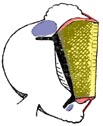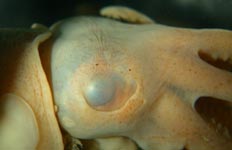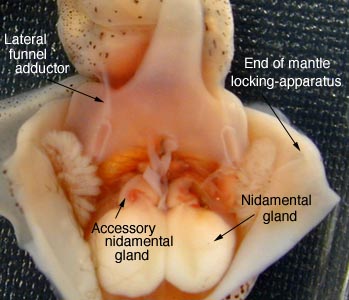Sepioidea
Michael Vecchione and Richard E. Young


This tree diagram shows the relationships between several groups of organisms.
The root of the current tree connects the organisms featured in this tree to their containing group and the rest of the Tree of Life. The basal branching point in the tree represents the ancestor of the other groups in the tree. This ancestor diversified over time into several descendent subgroups, which are represented as internal nodes and terminal taxa to the right.

You can click on the root to travel down the Tree of Life all the way to the root of all Life, and you can click on the names of descendent subgroups to travel up the Tree of Life all the way to individual species.
For more information on ToL tree formatting, please see Interpreting the Tree or Classification. To learn more about phylogenetic trees, please visit our Phylogenetic Biology pages.
close boxIntroduction
We place three families in the sepioid clade: Sepiidae, Sepiadariidae and Sepiolidae. The latter two families are related and placed in the suborder Sepiolida. Two additional families (Idiosepiidae, Spirulidae) have often been included in the Order Sepioidea. However considerable uncertainty exists concerning the relationships of the Idiospiidae in general and the closeness of the relationship of the Spirulidae to the sepioid families. Members of the sepioidea are mostly neritic and upper slope benthic species although one group (Heteroteuthinae) is pelagic.
Brief diagnosis:
A decapodiform ...
- with corneal membranes covering eye lenses.
- without branchial canals in gills.
- with circularis muscles in suckers.
Characteristics
- Arms
- Suckers with circularis muscles.
- Suckers with circularis muscles.
- Tentacles
- Tentacular club without proximal (= carpal) locking-apparatus.
- Suckers in more than four series (except in some Sepiolidae).
- Suckers with circularis muscles.
 Click on an image to view larger version & data in a new window
Click on an image to view larger version & data in a new window

Figure. Sections through the club suckers. Left - Sepia officinalis, arrow points to circularis muscle which encircles the sucker. Middle - Ommastrephes bartramii. Note absence of a circularis muscle. Right - Sepia officinalis, section at right angles to left figure, circularis muscle in blue; the asymmetry in the muscle is revealed by the angle of section. Histological sections made by Barbara Littman; photographed by R. Young. Drawing modified from Naef (1921-23).
- Buccal crown
- Buccal supports with or without suckers.
- Buccal supports with or without suckers.
- Head
- Head with tentacle pocket.
- Eyes with corneal membranes covering lenses.
- Eyes with secondary (= ventral) eyelid (except in some Sepiolidae).
- Funnel
- Funnel with lateral adductor muscles (except in some Sepiolidae).
- Mantle
- Mantle locking-apparatus does not reach anterior mantle margin (see arrow in above photograph which marks the anterior end of the mantle locking-apparatus) except in some Sepiolidae.
- Interstellate connective absent (ie, no direct nerve connective passes directly from one stellate ganglion to the other).
- Mantle locking-apparatus does not reach anterior mantle margin (see arrow in above photograph which marks the anterior end of the mantle locking-apparatus) except in some Sepiolidae.
- Fins
- Fins completely separate from one another; usually with posterior lobes.
- Fins completely separate from one another; usually with posterior lobes.
- Shell
- Shell a flattened phragmocone (=cuttlebone), a gladius or absent.
- Shell a flattened phragmocone (=cuttlebone), a gladius or absent.
- Viscera
- Gills without branchial canal.
- Right oviduct absent.
- Females with accessory nidamental glands.
- Eggs
- Eggs, where known, attached to substrate singly or in unorganized groups.
Synapomorphies
Many of the above characteristics of the Sepioidea are shared with the Myopsida. The characters that unite the Sepiidae and the Sepiolida and are considered to be apomorphic (newly derived) characters are:
- Eyes with secondary eyelids.
- Funnel with lateral adductor muscles.
- Mantle locking-apparatus that does not reach the mantle margin*.
- Absence of an interstellate connective.
- Gills without a branchial canal*,
*these characters seem to be independently derived in a few Myopsida.
About This Page

National Museum of Natural History, Washington, D. C. , USA

University of Hawaii, Honolulu, HI, USA
Page copyright © 2019 and
 Page: Tree of Life
Sepioidea .
Authored by
Michael Vecchione and Richard E. Young.
The TEXT of this page is licensed under the
Creative Commons Attribution-NonCommercial License - Version 3.0. Note that images and other media
featured on this page are each governed by their own license, and they may or may not be available
for reuse. Click on an image or a media link to access the media data window, which provides the
relevant licensing information. For the general terms and conditions of ToL material reuse and
redistribution, please see the Tree of Life Copyright
Policies.
Page: Tree of Life
Sepioidea .
Authored by
Michael Vecchione and Richard E. Young.
The TEXT of this page is licensed under the
Creative Commons Attribution-NonCommercial License - Version 3.0. Note that images and other media
featured on this page are each governed by their own license, and they may or may not be available
for reuse. Click on an image or a media link to access the media data window, which provides the
relevant licensing information. For the general terms and conditions of ToL material reuse and
redistribution, please see the Tree of Life Copyright
Policies.
- First online 18 August 2004
- Content changed 26 March 2019
Citing this page:
Vecchione, Michael and Richard E. Young. 2019. Sepioidea . Version 26 March 2019 (under construction). http://tolweb.org/Sepioidea/23870/2019.03.26 in The Tree of Life Web Project, http://tolweb.org/










 Go to quick links
Go to quick search
Go to navigation for this section of the ToL site
Go to detailed links for the ToL site
Go to quick links
Go to quick search
Go to navigation for this section of the ToL site
Go to detailed links for the ToL site